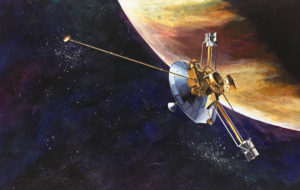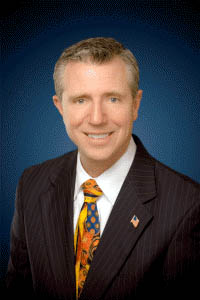Chamber of Commerce with Mark Turner: 1970s space probe to Jupiter teaches us leadership principles
Published in the September 21 – October 4, 2016 issue of Gilroy Life
By Mark Turner

Pioneer 10 illustration courtesy of NASA

Mark Turner
In 1972, NASA launched the exploratory space probe Pioneer 10. Its primary mission was to reach Jupiter, photograph the planet and its moons, and beam data to Earth. Scientists regarded this as a bold plan, for at that time no Earth space probe had ever gone beyond Mars, and they feared the asteroid belt would destroy the machine before it could reach its destination.
But Pioneer 10 accomplished its mission — and much, much more. Swinging past the Jovian planet in November 1973, Jupiter’s immense gravity hurled Pioneer 10 at a higher rate of speed toward the edge of the solar system. At one billion miles from the Sun, Pioneer 10 passed Saturn. At some two billion miles, it hurtled past Uranus; Neptune at nearly three billion miles; Pluto at almost four billion miles. By 1997, 25 years after its launch, Pioneer 10 was more than six billion miles from the Sun.
Despite that immense distance, Pioneer 10 continued to beam back radio signals to scientists on Earth. “Perhaps most remarkable,those signals emanate from an 8-watt transmitter, which radiates about as much power as a bedroom night light, and takes more than nine hours to reach Earth,” wrote Leon Jaroff in Time magazine,
“The Little Satellite That Could” was not qualified to do what it did. Engineers designed Pioneer 10 with a useful life of only three years. But it kept going and going. By simple longevity, its tiny 8-watt transmitter radio accomplished more than anyone thought possible.
The story of Pioneer 10 and the 8 watt transmitter is a testament to a well-designed plan and the boldness to carry it out. The story is also a helpful reminder of three important principles today’s business leaders and others need to apply if they want to boldly go where few dare to tread.
Know the Mission: One of Stephen Covey’s, “7 Habits of Highly Effective People,” is, “Start with the End in Mind.” In other words, know the mission. Know what you want to accomplish and begin to develop a plan to achieve it. Aimlessly wandering through the wilderness with no clear goal or objective demotivates all involved. When leaders and team members know the mission, everyone can remain focused, measure progress and avoid distractions.
While NASA feared there could be dangerous obstacles along Pioneer 10’s path, they still believed in the mission and knew exactly what they wanted to accomplish.
Go the Extra Mile: This is a phrase we often hear but seldom see in practice. It’s the extra effort, the additional effort that can bring about success. Many have said there are no traffic jams along the extra mile. In part it’s because so few people are willing to endure the burden longer than necessary. Much like the start of a marathon, many have the intention of finishing, but few have the endurance to go the distance.
There are challenges along the “extra mile.” For one, it’s a road that never ends. Good customer service is a one-time effort while great customer service is an ongoing effort. An excellent sales record comes from continued training, understanding the needs of the customer, courteously overcoming objections, never letting “no” be the final answer and an innate ability to be at your professional best in every situation. With so few people venturing in the direction of the extra mile, for those who do, it can feel desolate, remote and secluded. But it’s the extra mile where champions are made, fulfillment is accomplished, happiness is realized and success is achieved.
The question is this, what are you doing today that you didn’t do yesterday that will help you get to where you want to be tomorrow? Napoleon Hill said, “One of the most important principles of success is developing the habit of going the extra mile.”
Exceed People’s Expectations : Pioneer 10 was designed to accomplish the goal of reaching Jupiter, yet it accomplished far more than anyone could have imagined. It exceeded the expectations of those who designed it and knew its capabilities. Each of us and the organizations we work for are designed to achieve far more than we can imagine. The willingness to go the extra mile is what makes the difference between good and great.
Natalia Chrzanowska, content manager and author at Brand24, shares the story of Peter Shankman, an angel investor, who just before boarding his flight tweeted, asking Morton’s Steakhouse to meet him at the airport with a porterhouse steak when he landed. When he arrived he found a man wearing a tuxedo holding a bag with a juicy steak inside. He shared the experience on his Twitter profile immediately. A great example of jaw-dropping customer service.
Richard Branson, CEO of Virgin Group, said, “The key is to set realistic customer expectations, and then not to just meet them, but to exceed them — preferably in unexpected and helpful ways.”
Mark Turner is the president and CEO of the Gilroy Chamber of Commerce.
- Sports story: San Martin field of dreams teaches kids life lessons - September 2, 2024
- Guest column by Loretta McCarty: Banned books to get spotlight at Sept. 14 Gilroy Library sale - September 1, 2024
- Rich Firato: South Valley mourns ‘benevolent pirate’ who gave generously to community - September 1, 2024
